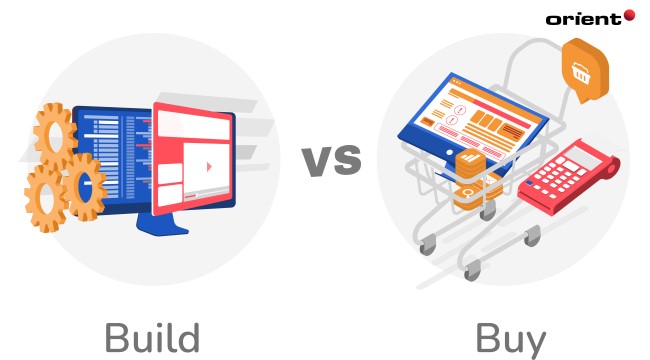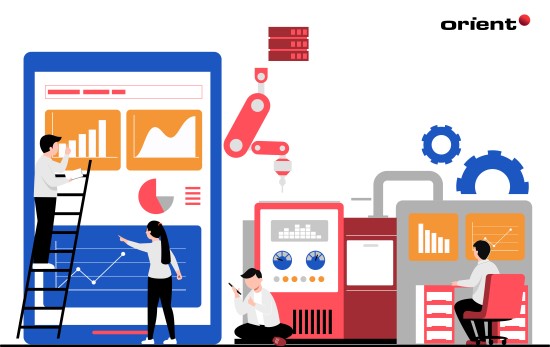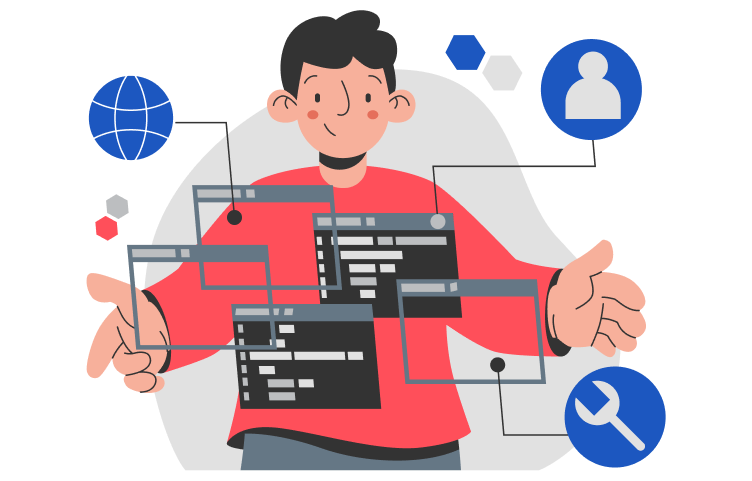Build Vs. Buy: What Factors to Consider Before Making a Decision?

Content Map
More chaptersWhen it comes to developing a new software system, one of the first decisions to be made is whether to build the system in-house or buy a pre-existing system. Both options have benefits and drawbacks, so it can be challenging to decide which is the best option for your business goals. Therefore, we will discuss some of the critical factors you need to consider when making this decision.
Build vs. Buy Decision in Software Development
When making decisions about information technology (IT) investments, organizations have two fundamental choices: build or buy. With the build option, the organization constructs the IT capability needed from scratch. The organization acquires an already-existing IT capability from a software vendor or other external sources with the buy option.
The decision of which option to pursue – build or buy – is not always clear-cut. Since both of these approaches have their own advantages and disadvantages, and they vary upon different needs, the optimal software solution for one organization may not be the best solution for another. Therefore, you will need to weigh all the benefits each approach offers and its drawbacks.
Pros and cons of Building Software Solution
Building software in-house generally requires less upfront investment than purchasing an off-the-shelf product. You are the one who understands your business better than anyone, so building software tailored to your specific needs can maximize efficiency and productivity as you desire. This is the top competitive advantage.
Custom-built software also offers greater flexibility than packaged solutions. As your business grows and changes, you can easily make changes to your software to accommodate those changes. Packaged software, on the other hand, may not be as flexible and may require significant investment to make changes.
Building custom software in-house also gives you more control over security and compliance. You can ensure that your software meets all relevant security and compliance standards by building it yourself. With off-the-shelf software, you may have to make significant changes to meet those standards, which can be costly.
On the downside, building software in-house generally takes longer and requires more internal resources than purchasing an off-the-shelf product. You will have to arrange time and money to design, develop, test, and deploy your software. And you will need to staff your own in-house team, which can be costly and time-consuming.
Pros and cons of Buying Software Solution
Purchasing an off-the-shelf software package generally requires less time and money than building software in-house. Off-the-shelf software is already developed, so you don’t have to allocate time and resources to designing, developing, and testing it. And, you don’t need to staff a software development team, which can save you a significant amount of resources and the opportunity cost.
The off-the-shelf custom solution also offers more features than custom-built software. Because packaged software is developed for a wide range of users, it generally includes more functions than software designed for a specific organization.
Another competitive advantage of buying software is that it’s usually easier to use than custom-built software. Packaged software is typically designed with a user-friendly interface that is easy to navigate. Custom-built software, on the other hand, maybe more difficult to use because it is not designed with a specific user interface in mind. Moreover, you can receive ongoing support from software vendors, which can be helpful if you encounter any problems using the software.
There are some disadvantages when you decide to buy software instead of building your own solution in-house. One disadvantage is that you may not be able to get the exact software that you want or need. Packaged software is designed for a wide range of users, so it may not include all the features that you require. Another disadvantage is that custom software may not be as secure as software that you build in-house.
Key Factors to Consider Whether to Build or Buy Software
There is no one-size-fits-all answer when it comes to deciding whether to build or buy a given piece of software. The decision must be made on a case-by-case basis, taking into account the organization’s specific needs in question. With that said, there are some factors that should be considered when making the build vs. buy framework decision. These include:
Cost
The cost of building software includes the cost of developing, maintaining, and upgrading the software over time. The cost of buying software consists of the purchase price and the cost of licensing and maintaining the software. By comparing the price gap between these two approaches, you can get a sense of which option is more cost-effective. This factor is essential because it can reduce costs and prevent technical debt in the long run. If the cost of building the software is prohibitive to your business, it may make more sense to purchase an off-the-shelf solution and vice versa.
Time
The time required to build software in-house can be significantly longer than the time required to buy software from a third party. If the organization needs a quick solution, in this case, purchasing an existing solution may be the better option.
Quality
It is often difficult to achieve the same level of quality with in-house software development as with commercial software. This is because commercial software is typically developed by experienced professionals who have access to better tools and resources. If quality is a key concern, it may be better to buy software from a reputable vendor. But if you have strong internal teams, then you can build your own software without worrying about quality issues.
Flexibility
In-house software can be customized to meet the specific needs of an organization, but it is not always possible to find a third-party solution that meets all of an organization’s requirements.
Risks
Developing software in-house can be a risky proposition, as there is no guarantee that the final product will meet all of the organization’s needs. Buying software from a third party carries its own risks, such as vendor dependence and the possibility of being locked into a particular platform or solution.
Project Scope
The scope of the project should be considered when making the decision to build or buy the software. If the project is small in scope, purchasing an existing solution may make more sense. However, if the project is large-scale or complex, the homegrown solution may be the better option.
In short, the final decision of whether to build or buy software must be made on a case-by-case basis based on the organization’s specific needs.
So, Build vs. Buy Decision - Which One Should You Choose?
All of the factors mentioned above are references for your consideration. The answer to this question depends on your specific business goals and requirements. There is no one-size-fits-all answer. If you want custom software that is tailored to your particular business needs, then building custom software in-house may be the best option. Otherwise, if you need software quickly and don’t have the time or resources to develop it yourself, purchasing an off-the-shelf product may be better.
One good way to make an informed decision is to consult with a good software outsourcing vendor that specializes in custom software development. They will assess your specific needs and requirements and recommend the best course of action.
Conclusion

In summary, the build vs. buy framework is an important decision that all businesses must make at some point. Each approach offers different advantages and disadvantages, so the only concern here is what you should choose to utilize. When making the final decision to build or buy the software, there are some key factors to consider. Cost, the time required, quality, flexibility, and risk are all essential considerations. The decision depends on the specific requirements of the organization in question. If you need a custom solution that you can have full control over and meet your specific business requirements, then building a software product in-house may be the best option. If you need software quickly and don’t have the time or resources to develop it yourself, purchasing an off-the-shelf product may be better. Now that you have the information you need, the rest is for you to decide.







